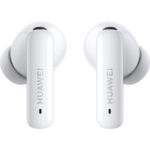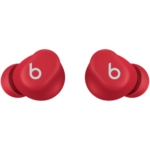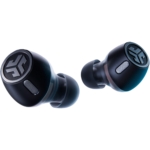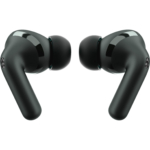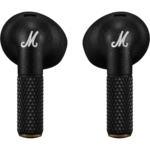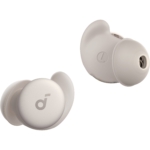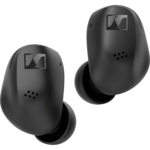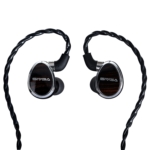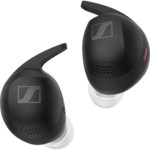The strengths of the Soundcore AeroFit by Anker are not limited to their high level of comfort and weather resistance. Despite their open-ear design, they also offer powerful sound reproduction, including BassUp technology, which largely compensates for the design-related loss of bass components.
- High wearing comfort
- Lightweight, compact design
- IPX7 water and sweat resistant earpiece
- Speech intelligibility when making calls
- Multipoint connections
- Handset and sound settings via app
- Volume loss with EQ
- No manual on/off switching possible
With the Soundcore AeroFit, Anker is expanding its range of True Wireless earbuds with this open-ear model that aims to combine the benefits of safe, comfortable listening with powerful sound reproduction. Four microphones that use an AI algorithm also ensure clear speech intelligibility when making phone calls.
Wireless open-ear headphones such as the Soundcore AeroFit are characterised by a high level of wearing comfort, as they rest in front of the auricle and do not sit in the ear canal like in-ear systems. The wearing position is held behind the ear by a bracket and does not exert any pressure; this is particularly beneficial for sensitive ears. There are also clear differences in terms of isolation, as earbuds with a headband provide much less shielding, which means that your surroundings can be perceived and responsiveness is enabled. The open-ear design undoubtedly increases your safety when using these earphones on the move or when taking part in sports.
With a weight of eight and a half grams per side, the Soundcore AeroFit are pleasantly light, and they are virtually imperceptible in the ears. The headband design prevents them from slipping too easily in everyday or sports use, but extreme movements such as skipping or jumping should be avoided. In such situations, the Pro version’s removable neckband offers extra support.
Comparison: AeroFit and AeroFit Pro
The more dainty AeroFit are IPX7 water and sweat-resistant and have touch controls. The more solid Pro model, on the other hand, fulfil the IPX5 standard, have push button controls and come with an optional neckband for sports use.
While the standard version supports the AAC format as a higher-quality audio codec, the AeroFit Pro is also equipped with high-resolution LDAC. Options such as spatial audio, optionally with or without head tracking, are also reserved for the Pro version. Instead, the AeroFit features Surround Sound. There are also differences in the driver size, which measures 16.2 millimetres on the Pro model and 14 millimetres on the AeroFit. However, the battery life is almost the same. Although the AeroFit Pro offered a longer listening time per charge, they utilised the battery reserve of their case more quickly, resulting in a comparable overall runtime.
Battery life
At a high volume, the Soundcore AeroFit can achieve a listening time of eleven hours and 15 minutes, and the earbuds can be fully charged in the case twice and once again with capacity for a further nine hours. This means that a total runtime of 42 hours and 45 minutes was available before an external power source was required. The case’s battery reserve was restored after 95 minutes using the USB-C to USB-A charging cable that was supplied as part of the package. The headphones can also be fully charged quite quickly, in just 45 minutes. If you’re in a hurry, a ten-minute quick charge can also provide capacity for up to four and a half hours of use.
Operation
These open-ear headphones support Bluetooth 5.3, multipoint connections with two devices simultaneously, as well as one-sided use in single mode. The wireless connection gave us an above-average impression of stability, meaning you can cross several rooms and change floors with ease. In their factory settings, the touch-sensitive headphone surfaces can be used to control playback, make phone calls and skip to the next track. If additional functions such as volume control, activating a voice assistant or skipping back are required, they can be retrofitted via the app. In addition to single and double tapping, controls can also be assigned to a hold gesture, and you can customise the touch control to suit your own preferences. However, there is no provision for manual switching on and off via the headphone surfaces, something which is supported by the buttons on the Pro model.
Soundcore app
In addition to the option to configure the touch control, the AeroFit’s app (for Android and iOS) offers sound control across three areas: The first option activates or deactivates the surround sound. The middle segment offers three preconfigured settings in addition to the basic sound: “Podcast”, “Treble Booster” and “Sound Amplifier”. Finally, an EQ provides eight bands for customised settings that can be saved as pre-sets. However, we noticed that the EQ section caused a noticeable loss of volume, which has not been the case with other Bluetooth headphones from this manufacturer and is something that can hopefully be rectified with a firmware update. The balance control, which can be found in the earphone settings, has been very well implemented, as it allows you to compensate for variations in the wearing position, as these can be caused by natural differences between different people’s ears. There is also a timer and a search function, which can help you find the earphones with a beep if you misplace them. You can also make multipoint connections and switch acoustic feedback on or off here.
Voice clarity when making calls
The open-ear design created an extremely pleasant conversation situation when communicating, as your own voice could be heard naturally. In addition, the four beamforming microphones of the Soundcore AeroFit ensured clean voice transmission, although the voice reproduction sounded even more authentic when using the Pro model.
Wind noise was largely filtered out and to the extent that it hardly caused any problems. Some wind noise did get through, but only when there were strong gusts from the side. Loud ambient noises were also significantly attenuated and could only be heard quietly in the background by the person on the other end of the line; your own voice could be clearly heard in the foreground. This worked really well! However, you should bear in mind that the open headband design will make it difficult for you to hear the other side of the conversation if the background noise is too loud.
Surround sound
Compared to the basic sound, the listening space widened, and the stage shifted deeper into the room, when surround sound was engaged, making the already expansive presentation of these open-ear headphones seem even more spacious. However, the reproduction seemed quite diffuse and lost precision, and this also had a negative impact on the intelligibility of film dialogue. In addition, the reproduction was rather lacking in power and pressure, as there was significantly less substance in the bass range, and this made listening to action-packed games and films less enjoyable.
Sound
The Soundcore AeroFit uses the manufacturer’s tried-and-tested BassUp technology to counteract the loss of bass due to the open-ear design. Bass compensation takes place automatically in real-time and can compensate for the design-related disadvantages of these open earbuds to a high degree. In terms of low bass, the result did not come close to comparable, proprietary True Wireless in-ears. But, for open-ear headphones, the reproduction seemed appealingly powerful and because the lower frequency range was not boosted too intensively, an open, expansive sound impression was retained.
Although the low bass was rather nuanced, modern music styles were reproduced quite tightly, with the mid-bass range providing a certain fullness and a defined sound. However, if you primarily listen to club music or hip-hop and want to use open-ear headphones, you would probably be better off with the Pro model, as the larger drivers reproduced a richer low end. Otherwise, these headphones still provided listening pleasure, even with the more balanced standard version.
Voice reproduction is a particular strength of the AeroFit. Thanks to the open headband design, voices were perceived as sounding very natural with a slight warmth. The speech intelligibility was impeccable when listening to music as well as when listening to podcasts, audiobooks or films. There was sufficient assertiveness in mobile use, but the sound was not too energetic when listening in a quiet environment. There were advantages when listening to more complex productions and live recordings, as these were widely dispersed and sounded airy without the outlines of the individual instruments becoming too blurred.
I noticed that at moderate volume levels, the treble reproduction was rather timid and restrained, which made the reproduction seem a little cloudy. In contrast, the sound image brightened at a higher playback volume, as the reproduction in the upper registers was noticeably more present, and this could result in a somewhat more concise representation of sibilants. When listening normally at a medium to slightly higher volume, however, the treble range blended in perfectly harmoniously, and this made the sound reproduction appear to be wonderfully coherent.
Conclusion
A clear strength of the Soundcore AeroFit is their high level of wearing comfort, especially as these weatherproof open-ear headphones allow you to be in contact with the environment. This is something that offers many advantages for both everyday and sports use. There is no need to sacrifice powerful sound reproduction, as you can largely compensate for the design-related loss of bass. The natural sound quality during phone calls and the lightweight, compact shape were also pleasing. For the moment, the loss of volume with the EQ gave us something to criticise, but this could be remedied with a firmware update.
Technical specifications
- Ear couplingOpen-Ear
- Typeopen
- Transducer principledynamic
- Weight without cable8.5 g each, Case 47 g
What's in the box
- USB-C to USB-A charging cable
- Charging case
Special features
- Available in black, white, pink and blue
- BT version: 5.3
- BT codec: SBC, AAC












